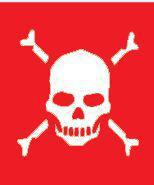SAS Urban Survival Handbook (135 page)
Read SAS Urban Survival Handbook Online
Authors: John Wiseman
Tags: #Health & Fitness, #Reference, #Survival, #Fiction, #Safety, #Self-Help, #Personal & Practical Guides, #General, #Survival Skills

WARNING
ALL people who have ‘nearly drowned’, but have been successfully revived, MUST SEEK URGENT MEDICAL ATTENTION. Delayed ‘drowning’ may occur up to 72 hours later, due to the presence of water in the lungs.
Other effects of immersion may include hypothermia—which is life-threatening—and, if the casualty has been in the water a long time, post-rescue collapse.
Post-rescue collapse is most common when a person has been in water for a long period and is suddenly lifted out (by air/sea rescue, for instance). The water pressure around the body is suddenly removed, causing the heart to work harder. In many cases this has led to tragic death after a person has been ‘saved’, although rescue techniques are being modified to cater for this. Lifting the casualty in a horizontal position has been found to lessen the effect of sudden removal from the water.
Action
In most cases there is little water in the lungs (if any)—don’t waste time trying to get it out, GET AIR IN! You MUST act as quickly as possible—if you can start resuscitation in the water, do so. Remove any debris in the casualty’s mouth and apply ☜ ‘MOUTH-TO-MOUTH. If ☜ CARDIAC COMPRESSION is also necessary, get the casualty out of the water—quickly.
Keep the casualty warm while waiting for help. When ‘stable’, place in the ☜ RECOVERY POSITION.
COLD WATER IMMERSION
Starting from a normal body heat of 37°C (98.6°F), a drop in body temperature to 35°C (95°F) is enough to lead to hypothermia. The swimmer may become confused and have difficulty breathing. At around 32°C (89.6°F), the heartbeat may become slower and irregular. Unconsciousness is usual at about 30°C (86°F). If the core temperature of the body drops down to as low as 25°C (77°F), death is likely.

WARNING
The cooling of the body’s core temperature will be greatly accelerated by the consumption of alcohol. It is estimated that a quarter of all deaths by drowning are also partly due to the lowering of the body’s temperature that alcohol causes.
REMEMBER
People have been resuscitated after ‘drowning’ up to 25 minutes later. NEVER give up attempts at resuscitation until help arrives. If the water is extremely cold, the casualty may fully recover—the dramatic reduction in body temperature can actually protect the brain.
CHILDBIRTH
If you are pregnant, it is VITAL that you seek regular medical attention. Follow any guidelines or instructions given by your doctor in preparation for childbirth. This may include changes in lifestyle—avoid physical and mental stress which can lead to premature birth/miscarriage. Prepare an emergency procedure for getting help and medical attention.
Even though emergency medical response time in cities is short, pregnant women in difficulty MUST receive first-aid assistance. Slight vaginal bleeding does NOT necessarily mean that a miscarriage is imminent—but medical attention should still be sought.
Miscarriage
Spontaneous abortion of foetus before week 28 of pregnancy. Risks include severe loss of blood (leading to ☜ SHOCK), possibly aggravated by the retention of some birth matter in the womb. Symptoms may include cramp-like pain in the lower abdomen, as well as vaginal bleeding and perhaps passing of birth matter.
- ◑ Reassure and keep the woman warm.
- ◑ Position her with head/shoulders supported and knees slightly raised, supported by a cushion/blanket to take strain from abdominal muscles.
- ◑ Monitor pulse and breathing.
- ◑ Place clean towel or sanitary pad between her legs.
- ◑ If bleeding is severe, treat for ☜ SHOCK.
- ◑ Save birth matter for medical examination later.
Labour
It is quite possible for a woman to go into labour at any time approaching the expected date of birth. In most births, there is no threat to mother or baby—but the warmer and cleaner the surroundings the better. There is usually time for the mother to be taken to a hospital, or for the emergency services to arrive and ‘take over’.
Normally the birth process follows clear stages—but there is no ‘rule book’. Every birth is different.

WARNING
If birth seems imminent, do NOT attempt to delay the emergence of the baby in any way.
STAGE ONE
This stage may take 12-14 hours for a first child, but less in a subsequent pregnancy:
- ■
Cramp-like pain in abdomen/lower back - ■
Contractions of the womb every 10-20 minutes accompanied by a small amount of blood-stained mucus (a sign that the cervix has begun to dilate) - ■
‘Waters’ break—the membrane containing the baby ruptures, discharging amniotic fluid
Once the ‘waters’ have broken—there may be a sudden rush of fluid or a prolonged ‘trickle’—this means that the baby is being born. Prepare for emergency childbirth.
The mother is likely to be anxious and frightened, particularly if it is her first baby. Help her to lie down with her head and shoulders raised—use pillows, coats or have someone cradle her from behind. Restrictive clothing should be removed, especially from the mother’s lower half.
Do what you can to arrange as much privacy as possible. Encourage the mother to draw up her knees, place a pad of towels, clothing or blankets underneath her hips for comfort. Keep her warm as much as possible.
Hygiene is VERY important to mother and baby but, in the back of a taxi (for instance), there is only so much you can do. If possible, wash your hands and use clean towels.
Stage two
This stage can take up to an hour. Keep the mother warm, calm and reassured.
- ◑ During a contraction, encourage mother to grasp her knees and pull her head towards them, pushing downwards.
- ◑ She should relax until the next contraction.
- ◑ Contractions normally become stronger and last longer as labour progresses.
- ◑ The area around the vagina and anus will begin to bulge as the baby’s head approaches.
- ◑ The baby’s head will begin to appear—get ready, birth is about to take place at any minute.
Stage three: Delivery
Support baby’s head as it begins to appear and hold clean towel over anus (if bowel movement occurs, wipe faeces AWAY from birth canal to avoid infection). Support baby’s head during each contraction. When crown (widest part) of baby’s head has passed through lower end of birth canal, tell mother to stop pushing and start panting.
- ◑ Still supporting the baby’s head to prevent it emerging too quickly, clear membrane and birth matter from the baby’s face and check that the umbilical cord is not caught around the baby’s neck.
- ◑ Still supported, the baby’s head will turn to one side as the body moves into position to travel down the birth canal.
- ◑ By lowering the baby’s head, you can help the ‘upper’ shoulder emerge.
- ◑ By gently lifting the baby, you can ease out the ‘lower’ shoulder and arm.
- ◑ Hold the baby gently around its chest, lift it up and out of the mother, placing it on her abdomen.

WARNING
DON’T pull on the umbilical cord—and BEWARE: The baby may be very slippery.
- ◑ Gently clean out the baby’s mouth and clean mucus away from its nostrils. It should cry and breathe naturally. If it does, wrap it up to keep it warm and lay it on its side with its face down to allow fluid to drain from the airway.
- ◑ If baby does not breathe, apply resuscitation techniques. It is NOT advisable to slap the baby!
Stage four
Afterbirth matter and the umbilical cord are normally released from the womb up to 30 minutes later, accompanied by mild contractions. The mother can help by ‘pushing’ this matter out. DON’T attempt to speed up the process by pulling.
Leave the umbilical cord and placenta, wrapped, beside the baby. When medical examination is possible, the afterbirth matter is needed to check whether anything has been left inside the mother—a potential cause of complications.
Clean the mother up and cover her. There may be some residual bleeding, but it’s not normally serious. Place a clean towel or absorbent material between the legs. If bleeding seems more excessive, DON’T worry the mother. Massage her abdomen gently and reassure her.
Editorial/design director
TONY SPALDING
Chief sub-editor
MANDIE RICKABY
Design/symbols
MIK BAINES/TONY SPALDING
Harvill editor
ANNE O’BRIEN
Production controller
LUCY RUTHERFORD
ACKNOWLEDGMENTS
Black-and-white illustrations
CHRIS LYON
Colour illustrations
SOPHIE ALLINGTON
(Bites & stings, Vectors)
NORMAN ARLOTT
(Plants)
CRAIG AUSTIN
/GARDEN STUDIO (Snakes 2)
GRAHAM AUSTIN
/GARDEN STUDIO (Dogs)
SEAN MAYERS
/GARDEN STUDIO (Fungi)
ANDREW RILEY
/GARDEN STUDIO (Snakes 1, Wood-boring insects)
SIMON THOMAS
(Water creatures)
Special thanks to
STOCKSIGNS LIMITED
for supplying signs artwork
Thanks also to:
| Janet Ahmed | British Museum of Natural History (Dept of Zoology) UK |
| Tim Shelford Bidwell | British Red Cross Society UK |
| Matthew Biggs | Building Research Establishment/Dept of Environment UK |
| Judy Bugg | Canadian High Commission UK |
| Ronald Clark | Emergency Preparedness Centre Ottawa Canada |
| Ian Devey | Federal Emergency Management Agency Washington DC |
| Paul Diamond | Friends of the Earth UK |
| ‘Gabriel’ | Greenpeace UK |
| Victor Stuart Graham | Guardian Angels UK |
| Adrian Louvain | Health and Safety Executive UK |
| Howard Loxton | St John Ambulance Association UK |
| Diana Miller | London Fire and Civil Defence Authority UK |
| Janice Nurski | London Underground Limited UK |
| Johnny Pinfold | The Met Office Berkshire UK |
| Kate Sekules | National Research Council Ottawa Canada |
| Bill Spalding | National Union of Journalists UK |
| David Squire | New Scotland Yard/Metropolitan Police UK |
| Kym Turner | Personal Protection Products UK |
| Christopher Winter | PSI Co. London UK |
| Queensland Museum Australia | |
| Royal Horticultural Society UK | |
| The School of Survival Hereford UK | |
| SEE RED London UK | |
| State Emergency Service Queensland Australia | |
| The Terrence Higgins Trust UK | |
| Total Security Systems Limited UK | |
| Trades Union Congress UK | |
| United States of America Embassy UK |